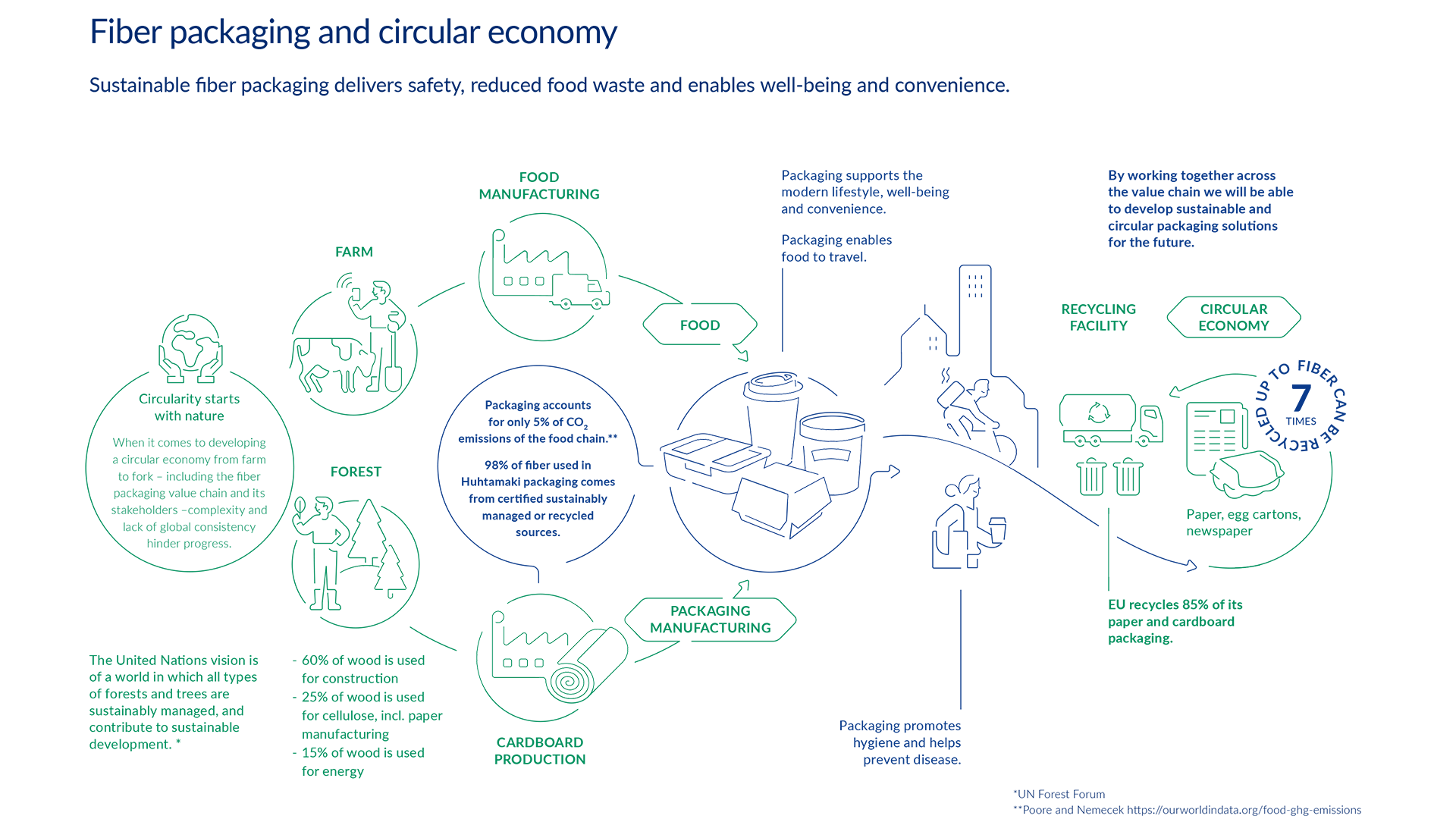Designing for circularity
To contribute to the transition to a circular economy and help our customers reach their sustainability targets, we work on integrating circularity across systems and products.
At Huhtamaki, we design products with circular economy as a guiding principle. Our mission to make packaging more circular globally has forged valuable collaborations with our customers, partners and trade associations to gather the right knowledge and develop solutions.
Our ambition is that 100% of our products are designed to be recyclable, compostable or reusable. By 2030, over 80% of the materials we use are renewable or recycled, and 100% of the fiber we source is either recycled or from certified sources.
We acknowledge that the actual level of recycling, composting and reuse depends also on the local recycling infrastructure and on the willingness of consumers to participate in recycling schemes. We aim to accelerate the development of collection, sorting and recycling infrastructure by working together with our value chain.
Enabling a circular economy together with our value chain
Our Design principles help us take a life-cycle approach and make informed decisions when designing our products
As a global packaging solution provider, we are committed to contributing to the transition from a linear to a circular economy, where products and materials are kept in circulation in a closed-loop system. This change starts from our product design and affects the entire life-cycle of products. We have developed Design principles for ensuring innovation and new product development towards the goal of achieving circularity.
Our Design principles for circularity in our products set the foundation for our technical design framework. These principles are the building blocks for the integration of circularity into the design of our products, within each business segment of Huhtamaki.
When developing our products, we are guided by the following key principles:
Material selection: The main materials we use are renewable materials, recycled materials and polymers.
We are material positive, meaning that we make the best possible choice in the selection of materials to ensure environmentally viable, functional, fit-for-purpose packaging, which supports how we play our part in delivering systems which are both circular and low carbon. In a material positive system, the materials which provide access to safe, affordable food and help prevent food waste, then continue their journey through a low carbon circular economy by being recycled in ways that maximize their value to both the planet and people.
Product structure: We make sure circularity is considered in the product design and structure, by designing high quality, durable packaging that is fit for purpose, without excessive use of packaging, and by optimizing the amount of materials and resources used in our products while ensuring technical recyclability.
Product end-of-life: We are committed to increasing the recyclability of our products. We use materials compatible with collection and recovery systems, ensure sufficient consumer information and ease of use for collection and support easy, automatic sorting. We see waste as a valuable secondary resource and want to ensure that materials are kept in circulation for as long as possible through recycling, composting, or reusing.
Download our Design principles for circularity in our products here
We believe that the key to creating sustainable innovation lies in partnering with multiple stakeholders across the value chain to address the challenges and opportunities we face today. To deliver on a green economic recovery we need to create the right legislative framework for innovation and systemic change for a circular economy together. Our mission to make packaging more circular globally, has forged valuable collaborations with our customers and partners to gather the right knowledge and develop solutions for greater recyclability.
Launched by Huhtamaki, Think Circle is a platform that brings together multi-perspective stakeholders from across the global food value chain to address issues facing us as we try to find solutions for a circular economy.
Huhtamaki and Stora Enso launched a new paper cup recycling initiative, The Cup Collective, in September 2022. Being made up primarily from virgin fiber, paper cups are easily recyclable, but in practice the overwhelming majority of used cups are discarded in general waste, making recycling very difficult. The Cup Collective addresses this challenge by accelerating paper cup recycling across Europe at an industrial scale, aiming to recycle half a billion paper cups in the first two years, while making it easy for consumers and businesses to contribute.
The Cup Collective is focused on reducing the environmental impact of paper cups by creating a transparent, open-loop recycling system that integrates paper cups into the circular economy. This maximizes the opportunity to recycle the cups many more times – for example, from cup to magazine, to cup-carrier, to cardboard – generating added value every step of the way by prolonging the wood fiber’s life cycle. The initiative went live in December thanks to the partnership with McDonalds, SSP (The Food Travel Experts), C2 Centre and the National Railway Company of Belgium (SNCB). The first paper cup collection bins are now installed in restaurants, cafés, office buildings and transport hubs in the Benelux countries, with collection volumes expected to be scaled up in 2023.
Read more about the Cup Collective
Read more about our products on our business segment's own sites:
Huhtamaki Fiber and Foodservice E-A-O
Or, you can contact us to find out more about our sustainable products.

